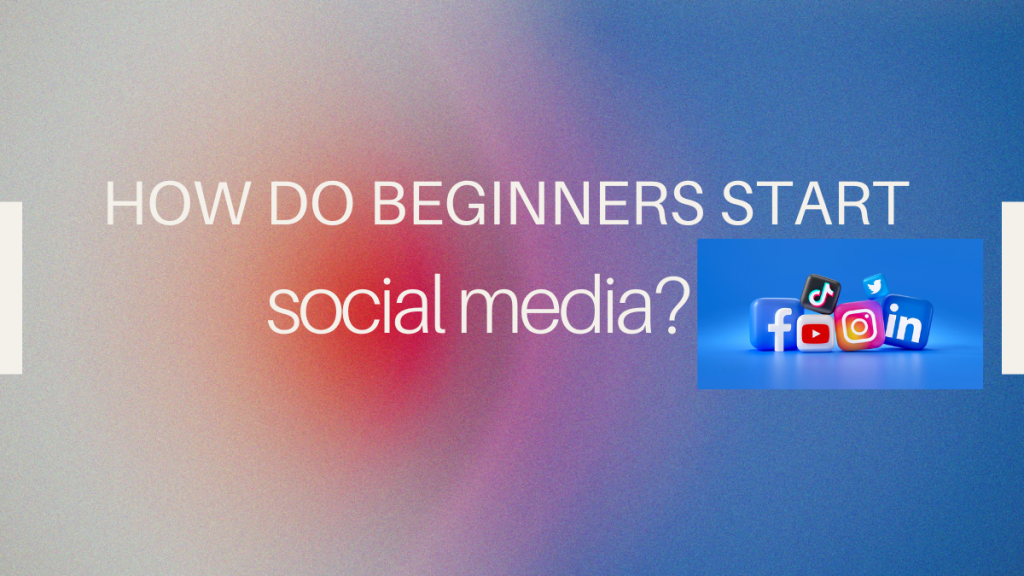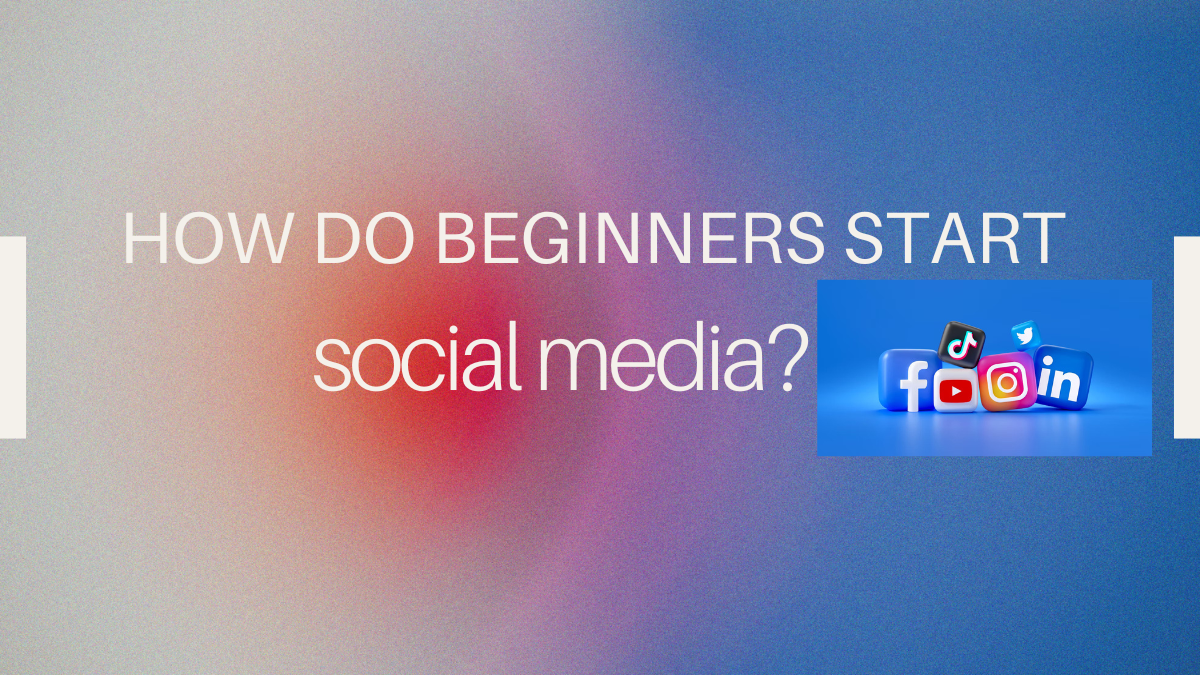Feeling a bit lost when it comes to social media marketing for your business or personal brand? You’re definitely not alone! I’ve been in the same boat and have often wondered “How do beginners start social media marketing?”. The digital landscape can surely seem vast and intimidating, filled with buzzwords, algorithms, and a constant stream of content. Like myself, you might even ask yourself, “Is social media marketing easy?”. The truth is, while it requires dedication and learning, it’s far from impossible. If you’ve ever dreamt of becoming a social media marketer or even pondered “how to start SMMA” (Social Media Marketing Agency), mastering the basics of online presence is the core first step and this guide is designed to help you with just that.
In this blog, we’ll demystify how do beginners start social media marketing/social media marketing for beginners. We’re going to break down everything you need to know, from the absolute fundamentals to actionable strategies. We’ll tackle common questions like, “Is social media marketing easy?” (and provide a realistic perspective!), dive into what many consider “the biggest challenge in marketing,” and help you strategically answer “what social media platform is best for marketing” for your specific goals. Furthermore, we’ll uncover the foundational “5 pillars of social media marketing” that will guide your efforts, explore practical content strategies like the “50/30/20 rule,” and much, much more.
Prepare yourself transform your social media presence from daunting to dynamic!

The Heart of a Social Media Marketing Strategy: Define Your “Why” & “Who”
When I started diving into social media marketing, one of the first lessons I learned was that there are very less chances of random posting working. What works is when you know exactly why you’re on social media and who you’re trying to talk to. This is where “how do beginners start social media marketing” comes and we try to answer it effectively to help you understand the gist of social media marketing: strategy.

Goals
First, let’s talk about goals. What do you truly want to achieve by being on social media? Don’t just say “more followers.” Be specific! Are you looking to build brand awareness so more people recognize your business, are you aiming to generate leads for your services, or are you trying to drive direct sales for your products? Whatever your goals are, I strongly recommend making your goals SMART:
- Specific: Instead of “get more sales,” try “increase online sales by 18%.”
- Measurable: Your goals should be measurable. Use website analytics, engagement rates, etc.
- Achievable: Ensure the goal is realistic given your resources and timeframe.
- Relevant: Ask yourself, does this goal align with your overall business objectives?
- Time-bound: Don’t be vague. Set a deadline, such as by the end of Q3.
Setting SMART goals gives you a clear target to aim for, making it easier to answer, “Can you teach yourself social media marketing?”. The answer is a yes, particularly when you have clear objectives guiding your learning.
Define Target Audience
Next up is defining your target audience, also often known as a Buyer Persona.
Defining the target audience is pretty straightforward. Start with:
- Demographics: Age, gender, location, income, education.
- Psychographics: Interests, hobbies, values, attitudes, lifestyle choices.
- Pain Points: What problems do they have that your product or service solves? What keeps them up at night?
- Online Habits: Which social media platforms do they spend most of their time on? What kind of content do they consume?
This deep understanding of your audience will have multiple effects on your social media marketing efforts. It will enhance your content but help you identify where to spend your time. When you define your audience and when you know who you are speaking to, the answer to “Can I do social media marketing myself?”. In other words, defining your target audience makes it easier to do social media marketing yourself.
Decide Where to Focus Your Efforts
After setting your goals and defining your target audience, now comes a crucial decision for social media marketing for beginners: where are you going to focus your efforts? This is often related to “what social media platform is best for marketing,” and it’s a question I get asked all the time.
Takes Things Step by Step
I cannot stress this enough: don’t join every single social media platform. This is the reason most beginners for social media end up failing! Initially, when I started out, I was under the impression that more platforms meant more reach. But, I was wrong.
When you spread yourself on all social media platforms, you get overwhelmed and burnt out. Rather, what you should do is to have a strong, consistent presence on one or two platforms like Facebook and Instagram than a weak, presence on six. When it comes to social media marketing, quality wins over quantity every single time.
To choose the right platform, see where your audience actually spends their time, rather than focusing on the platform popularity only.
Match Your Audience to Your Platform
Next up is matching your audience to your platform. Here, the question of “how to market a product on social media,” also comes in.
You need to be where your ideal customers are already hanging out. Its true that the “4 P’s of social media marketing” (People, Platform, Purpose, Performance) and the “5 pillars of social media marketing” are critical to a broader social media marketing strategy, the “Platform” pillar is incredibly important in 2025. Here’s how I would typically approach platform selection based on my brand type and its focus.
- Instagram: If my brand thrives on visuals, aesthetic appeal, and a lifestyle focus, I would choose Instagram. Instagram has worked wonders for e-commerce, fashion, food, and travel brands, and appeals heavily to younger demographics and those who engage with influencers.
- Facebook: If my target audience is broader in age range, or if I’m focused on local businesses, community building through groups, or event promotion, I’d focus on Facebook. Facebook is still a powerhouse and it’s versatile for longer-form content and building detailed profiles.
- TikTok: If I have explosive, viral potential with short-form, authentic video content, and my audience is Gen Z or younger millennials, TikTok is where I’d lean. It’s all about trends, creativity, and raw connection.
- LinkedIn: For professional services, thought leadership, and networking within specific industries, I’d choose LinkedIn. It is best known to connect with other professionals and share industry insights.
- X (formerly Twitter): Ideal for real-time news, quick updates, engaging in public discussions, and often used for responsive customer service. If my content is brief, timely, and sparks conversation, I’d opt for X.
- Pinterest: A visual discovery engine perfect for inspiration, DIY, recipes, home decor, and product showcasing. If my product solves a problem or sparks creativity through visuals, I’d definitely consider Pinterest.
While there are other platforms like YouTube, which is excellent for in-depth tutorials, vlogging, and building authority, I’d say pick just one or two platforms where your defined target audience is most active and where your content can truly shine. Don’t ever try to conquer all social media platforms all at once. Focus your energy, master those chosen platforms, and then, and only then, consider expanding.
Making Your Presence Felt Through Consistency and Engagement

So, you’ve got your platform, your audience, and some amazing content ideas cooking. Now comes the part the to make your social media marketing efforts visible and impactful: consistency and engagement. For beginners wondering “how do beginners do social media marketing,” this element is critical. It’s not just about what you post, but how reliably and interactively you show up.
The Power of Consistency
What I have learned in social media marketing for beginners is that quality is consistently greater than quantity. Rather than posting five times a day, its better to post a few truly valuable, engaging pieces of content each week than to have boring posts that no one reads. Its also important to set a realistic posting schedule that you can genuinely stick to – whether that’s three times a week, every other day, or daily Stories.
To help with this, you should do what I did: create a content calendar. You can use a simple spreadsheet to create one, plan your topics, content types (image, video, poll), and posting dates in advance. Tools like Mailchimp’s social media post scheduler can incredibly ease this burden, allowing you to plan and schedule your posts across social media platforms like Facebook and Instagram ahead of time. I’ve found that seeing my content mapped out reduced my stress immensely, and it ensured I’m thinking strategically about what I’m sharing. This structured approach is a core part of “what is in a social media marketing campaign” – and its all about planning and purposeful action.
Engage, Don’t Just Post
Social media is a conversation. I always tell people, “social media is a two-way street”. Think of it as building friendships, not just broadcasting. If you’re just posting and then disappearing, you’re missing the entire point. This is fundamental for “social media marketing for beginners.”
To engage:
- Respond to comments and DMs: Always take the time out to comment or send a direct message to someone who sends you a message. Show them you’re interested, you’re listening, and that you value their input. Doing so will build loyalty and community.
- Ask questions: Always use interactive questions, as doing so will encourage comments and spark conversations.
- Engage with others: Don’t follow the sit and wait strategy. Instead, actively follow relevant accounts in your niche, comment genuinely on their posts, and share content that aligns with your audience. For those asking ‘how do I start marketing for beginners”, this is a crucial point to remember.
- Community Building: Think long-term and build a community. Think about how can you foster a sense of belonging? In my opinion, regular Q&A sessions, user-generated content features, and even creating a dedicated group are great options to begin with.
Scheduling Tools
Once you start growing, manually posting everything can become problematic. This is where social media management platforms come in handy. I’ve personally used tools like Hootsuite and Later, and as mentioned, Mailchimp also offers robust social media scheduling tools. These platforms allow you to do a lot, including scheduling or instantly publishing posts, managing multiple social media accounts, and even tracking performance all in one place. Some, like Mailchimp, even feature AI tools that can generate social media posts based on your previous marketing campaigns, which can save you a lot of time! However, while these tools are amazing for efficiency, don’t rely on them exclusively. You still should log in manually to respond to comments, engage with other users, and jump into real-time conversations. Automated posting is good, but authentic engagement is invaluable.
The Best Metrics to Measure Social Media Success for Beginners

Many people are interested in finding out how much does social media marketing cost. How much does it cost to start social media marketing in terms of your time and effort, you need to see what’s actually working. This can be done through metrics. Measuring is also the final stage and its all about learning, adapting, and refining your approach.
Don’t Obsess Over Likes
Every time I review my social media performance, I avoid getting caught up in metrics like the number of likes or followers. While they feel good, they’re not necessarily the whole deal. Instead, focus on metrics that align directly with your initial SMART goals that we discussed earlier.
- Reach: Reach is good for brand awareness and its how many unique people saw your content.
- Engagement Rate: Engagement rate is fantastic for community building. It is what percentage of your audience interacted with your post through likes, comments, shares, and saves.
- Website Clicks: This shows how many people visited your site from social media? Key for leads and sales.
- Leads Generated: When a social post directly result in a new inquiry or customer, it is a lead. Measuring lead generation is one of the best and true metrics for analyzing social media performance.
Measuring social media performance has become easy with tools like Platform Analytics (often called “Insights” or “Analytics”, which are built in the social media platform. These dashboards provide a wealth of data about your audience and content performance. Make sure to keep an eye on them regularly!
Learn, Adapt, Optimize
Since social media is constantly evolving, what worked yesterday might not work tomorrow, and that’s okay. My approach is always to “Think of it as a science experiment – hypothesis, test, analyze, repeat!”
- First see what’s working? Look at your high-performing posts. What was unique about them? Was it the type of content, the topic, the time of day, or the call to action?
- What isn’t? Identify posts that flopped. Why might they have underperformed?
- Don’t be afraid to try new things. If you see videos are skyrocketing, experiment with a new video format. If a certain hashtag isn’t driving results, try another.
With constant learning and adaptation, your social media approach will always keep improving.
What Is The 50/30/20 Rule For Social Media?

Everything’s aligned, your goals, your audience, and your platform. Now, what do you actually post? This is where content strategy comes in, and for beginners, content rules like the 50/30/20 rule for social media can be incredibly helpful.
The 50/30/20 is not a strict law. Instead, its a flexible guideline made to ensure your content mix is balanced, valuable, and keeps your audience engaged without making them feel like you’re constantly selling. I feel sticking to it helps prevent content fatigue – for both me and my audience!
Here’s how I break it down:
- 50% – Curated Content: 50% of your content should be about sharing valuable, relevant content from other sources. Think industry news, interesting articles, research, or content from complementary businesses (not direct competitors, of course!). This shows you’re a resource, not just a broadcaster. For example, if i have a small online bakery, my 50% of curated content may involve sharing an article about new baking trends, a post from a local shop I admire, or a statistic about the benefits of supporting small businesses. This strategy is also sometimes is also called the 90/10/1 rule on social media, where 90% of content is curated, 10% is original, and 1% is directly promotional.
- 30% – Original Content: This is your unique voice. This portion is dedicated to creating your own content that provides value, educates, entertains, or inspires your audience. This could be blog posts, original videos, infographics, photos of your products, behind-the-scenes glimpses, or personal insights. For my bakery, this would be pictures of my latest cake creation, a short video showing me decorating a cake with fancy decorations, or a post sharing a fun fact about flour. This one is important, as it helps establish your brand’s identity.
- 20% – Promotional Content: This is where you directly promote your products, services, events, or special offers. The percentage is smaller to avoid spamming your audience and turning them off.
Other questions asked in social media marketing for beginners are:
- What is the 80/20 rule marketing content? This one means 80% of your content should provide value, educate, or entertain, and only 20% should be directly promotional.
- What is the 5-3-2 content strategy? An important content guideline, used daily or weekly: 5 pieces of curated content, 3 pieces of original content, and 2 pieces of personal/fun content.
- What is the 5-3-1 rule on Instagram? Like the above, it refers to 5 curated posts, 3 original posts, and 1 direct promotional post within a given timeframe (e.g., a week).
- What is the 5-5-5 rule on social media? This one is more about engagement: posting 5 original pieces, sharing 5 relevant pieces of curated content, and actively engaging with 5 other posts.
- What is the 5-3-2 business model? Less of a content strategy and more of a sales/business strategy, often relating to lead generation or customer touchpoints.
What Are the 5 Pillars of Social Media Marketing?
Understanding what are the 5 pillars of social media marketing is essential for building a strong digital presence. These pillars are:
1- Strategy
2- Planning & Publishing
3- Listening & Engagement
4- Analytics & Reporting
5- Advertising.
Together, they guide brands in creating valuable, consistent, and data-driven content.
While often asked alongside, what are the 4 P’s of social media marketing—Product, Price, Place, and Promotion, the 5 pillars of social media marketing focus more on adapting traditional marketing principles for online platforms.
Another key concept is what is the 80 20 rule for social media marketing. This rule suggests that 80% of your content should inform, entertain, or educate your audience, while only 20% should directly promote your business. The 80 20 rule builds trust, encourages interaction, and drives long-term engagement.
How To Create A Killer Social Media Strategy With 8 Simple Steps?

Before you get to things like how to market a product on social media, you need a clear social media strategy to do it effectively.
The best social media strategy, often also framed as what is in a social media marketing campaign, starts and ends with the following (we’ve already covered these in the blog post but here’s a quick overview for our enthusiastic readers):
- Define Your Goals: Start with what do you want to achieve? Be SMART (Specific, Measurable, Achievable, Relevant, Time-bound).
- Know Your Target Audience Thoroughly: When trying to understand your target audience, answer these questions, who are you trying to reach? What are their demographics, pain points, and online behaviors? Knowing your audience inside and out will be your guiding force in which platforms you use, what kind of content you create, and even the tone of your messages.
- Conduct a Competitor Analysis: See what your competitors are doing well and where they might be falling short. This one’s all about identifying opportunities to differentiate yourself and discover what resonates within your niche.
- Choose Your Core Social Media Platforms: Don’t try to be on and cover every social media platform! How do beginners do social media marketing is all about picking 1-2 platforms where your ideal customers spend most of their time based on your target audience. Its also about focusing on quality engagement than quantity. If you’re unsure “what social media platform is best for marketing”, choose one (with my guidelines above) based on your brand type.
- Develop Your Content Strategy & Pillars: What types of content will you create, and what broad themes will they fall under? Think about educating, entertaining, inspiring, and then promoting. Use rules like the 80/20 or 50/30/20 rule to guide your content mix.
- Create a Content Calendar: This one’s a must do- plan your posts in advance! A simple spreadsheet is enough to start.
- Implement and Engage Consistently: Start posting according to your calendar, but don’t just set it and forget it. Actively engage with your audience by responding to comments, answering DMs, asking questions, and interacting with other relevant accounts.
- Monitor, Analyze, and Adapt: Regularly check your platform analytics to see your social media performance and adjust your strategy over time. Social media is dynamic; your strategy should be too.
Conclusion
When you are new to social media marketing, it may seem like a huge task, but it really boils down to a few simple steps. If you are a beginner and wondering how do beginners start social media marketing, focus on the basics: figure out what you want to achieve, find out which social media platform your potential customers use most, and then consistently share stuff that they’ll actually find useful and entertaining. Don’t worry about being perfect right away. Just get started, see what works, and adjust as you go. By engaging with your audience and being consistent about it, you’ll slowly but surely build a great presence online.
Want to learn more about the digital marketing world? Check out our blog on how to get an AI overview on Google, the best SEO strategy, and how to write the perfect email copy. Stay tuned for the latest and newest in social media marketing at The Sharp Marketer!
FAQs
How to start SMMA as a beginner?
You can start an SMMA as a beginner by learning core social media marketing skills and getting results for your own brand or a friend’s. Build your portfolio, whether small, and then offer services to local businesses. However, focus on one or two platforms initially.
How successful is social media marketing?
Social media marketing can be super successful, as it greatly helps businesses build brand awareness, foster communities, drive website traffic, and generate significant sales.
What is the job role of social media marketing?
The job role of a social media marketer is to plan, create, and publish content across social platforms, engage with the audience, analyze performance data, and adapt strategies to meet specific marketing goals.
How much social media per day is ok?
For marketing, “how much is okay” depends on your strategy and audience’s activity; focus on consistent, quality posts and active engagement, not only the total hours spent.
How do I start selling on social media?
You can start selling on social media by building an engaged audience through valuable content, then introducing your products/services naturally within your content mix. Utilize platform features like shopping tags, product catalogs, and clear calls to action to guide purchases.
How can I become a social media marketer as a beginner?
You can become a social media marketer as a beginner by learning the fundamentals through online courses or free resources, practice by managing your own or a small business’s social media, build a portfolio of successful campaigns, and then seek entry-level opportunities or freelance clients.
What is the golden rule of marketing?
The golden rule of marketing is to “market unto others as you would have them market unto you”. In layman terms, it means always put your customer first, provide genuine value, and build trust, rather than just pushing sales.
